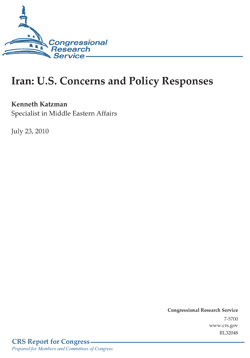Иран: поводы для беспокойства США и возможные политические ответы
19 августа 2010

Summary
The Obama Administration has continued the long-standing characterization of Iran as a “profound threat to U.S. national security interests.” This threat perception has been generated not only by Iran’s nuclear program but also by its military assistance to armed groups in Iraq and Afghanistan, to the Palestinian group Hamas, and to Lebanese Hezbollah. In its first year, the Obama Administration altered the previous U.S. approach by expanding direct diplomatic engagement with Iran’s government and by offering Iran’s leaders an alternative vision of closer integration with and acceptance by the West. To try to convince Iranian leaders of peaceful U.S. intent, the Obama Administration downplayed discussion of potential U.S. military action against Iranian nuclear facilities and repeatedly insisted that it did not seek to change Iran’s regime. It held to this position even at the height of the protests by the domestic opposition “Green movement” that emerged following Iran’s June 12, 2009, presidential election.
Iran’s refusal to accept the details of an October 1, 2009, tentative agreement to lessen concerns about its nuclear intentions—coupled with its crackdown on the Green movement—caused the Administration, in 2010, to shift away from engaging Iran’s leaders and toward building multilateral support for economic sanctions against Iran. The Administration efforts bore fruit on May 18, 2010, when it announced an agreement among permanent members of the U.N. Security Council that would authorize, but not require, countries to take a number of significant steps against Iran, including banning major arms sales to Iran and authorizing inspection of ships suspected of carrying equipment for Iran’s nuclear program. U.N. Security Council Resolution 1929 containing these provisions was passed on June 9 by a vote of 12-2 with one abstention. The resolution represented a rejection of a May 17, 2010, agreement brokered by Brazil and Turkey to implement major features of the October 1, 2009, agreement. This U.N. resolution was followed by congressional passage of major new sanctions legislation—P.L. 111-195, signed July 1, 2010.
Some of Iran’s leaders are expressing concerns about Iran’s apparently growing economic isolation. Numerous foreign firms have been announcing their exit from the Iranian market, and U.S. allies are imposing new sanctions to align both with the U.N. resolutions as well as with some U.S. unilateral sanctions. However, because the sanctions have not caused Iran to fundamentally alter its commitment to its nuclear program, the Administration reportedly has revived deliberations of possible military action to try to set Iran’s nuclear program back, or to undertake options to contain Iran. Some believe that Iran’s domestic opposition, which in late 2009 appeared to pose a potentially serious challenge to the regime’s grip on power, may provide the only clear opportunity to reduce the potential threat of a nuclear Iran. Obama Administration officials appear to believe that the opposition’s prospects are enhanced by a low U.S. public profile on the unrest. Congressional resolutions and legislation since mid-2009 show growing congressional support for steps to enhance the opposition’s prospects. Others maintain that the prospects for the domestic opposition, which has been largely absent from the streets in 2010, are poor, and that other options are fraught with risks, and that the Administration should return to a focus on reaching a nuclear agreement with Iran. For further information, see CRS Report RS20871, Iran Sanctions; CRS Report R40849, Iran: Regional Perspectives and U.S. Policy; and CRS Report RL34544, Iran’s Nuclear Program: Status.
Contents
Political History
Regime Structure, Stability, and Opposition
The Supreme Leader, His Powers, and Other Ruling Councils
The Presidency/Mahmoud Ahmadinejad
Ahmadinejad’s Policies and Political Position
June 12, 2009, Presidential Elections
Domestic Unrest: Election Dispute and Emergence of the “Green Movement”
Green Movement Formation
How Shaken and Divided Is the Regime?
Additional Political Fallout of Economic Sanctions
Long-standing Opposition Groups in Exile
People’s Mojahedin Organization of Iran (PMOI)/CampAshraf
The Son of the Former Shah
Ethnic or Religiously Based Armed Groups
Other U.S.-Based Activists
Other Human Rights Practices
Iran’s Strategic Capabilities andWeapons of Mass Destruction Programs
Conventional Military/Revolutionary Guard/Qods Force
Nuclear Program and Related International Diplomacy
Iranian Recent Nuclear Activities
Iran’s Arguments
The International Response
The International Response Under the Obama Administration
Possible Additional International and Multilateral Sanctions to Address Iran’s Nuclear Program
ChemicalWeapons, BiologicalWeapons, and Missiles
Ballistic Missiles/Warheads
Foreign Policy and Support for Terrorist Groups
Relations with the Persian Gulf States
Iranian Policy in Iraq
Supporting Palestinian Militant Groups
Iran and Hamas
Lebanese Hezbollah and Syria
Syria
CentralAsia and the Caspian
South Asia: Afghanistan, Pakistan, and India
Afghanistan
Pakistan
India
Al Qaeda
Latin America
Venezuela
Africa
Additional U.S. Policy Responses and Options
Clinton Administration Policy
George W. Bush Administration Policy
Overview of Obama Administration Policy
Implementation of the Engagement Policy
Military Action
An Israeli Strike?
Iranian Retaliatory Scenarios
Containment and the Gulf Security Dialogue
Presidential Authorities and Legislation
Regime Change
Democracy Promotion Efforts
Further U.S. and International Sanctions
Ban on U.S. Trade With and Investment in Iran
U.S. SanctionsAgainst Foreign Firms that Invest in Iran’s Energy Sector
Targeted Financial Measures byTreasury Department
Terrorism List Designation Sanctions
Sanctions Against Foreign Firms that Aid Iran’s Weapons of Mass Destruction Programs
Sanctions Against Foreign Firms that Sell Advanced Arms to Iran
Ban on Transactions With Foreign Entities Determined to Be Supporting International Terrorism
Ban onTransactionsWith Foreign Entities that Support Proliferation
Divestment
Counter-Narcotics
U.S.-Iran Assets Disputes
Travel-Related Guidance
Conclusion
Figures
Figure 1. Structure of the Iranian Government
Figure 2. Map of Iran
Tables
Table 1. Major Factions and Personalities
Table 2. Factions in the Eighth Majles
Table 3. Human Rights Practices
Table 4. Iran’s Conventional MilitaryArsenal
Table 5. The Revolutionary Guard
Table 6.Summary of Provisions of U.N. Resolutions on Iran Nuclear Program (1737, 1747, 1803, and 1929)
Table 7. Iran’s Ballistic Missile Arsenal
Table 8. Iran Democracy Promotion Funding
Table 9. Selected Economic Indicators
Вернуться назад